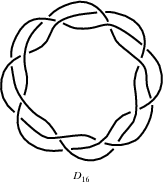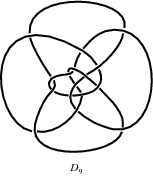


 تاريخ الرياضيات
تاريخ الرياضيات
 الرياضيات في الحضارات المختلفة
الرياضيات في الحضارات المختلفة 
 الرياضيات المتقطعة
الرياضيات المتقطعة
 الجبر
الجبر
 الهندسة
الهندسة 
 المعادلات التفاضلية و التكاملية
المعادلات التفاضلية و التكاملية 
 التحليل
التحليل
 علماء الرياضيات
علماء الرياضيات |
Read More
Date: 21-7-2021
Date: 28-7-2021
Date: 14-6-2021
|
A symmetry of a knot  is a homeomorphism of
is a homeomorphism of  which maps
which maps  onto itself. More succinctly, a knot symmetry is a homeomorphism of the pair of spaces
onto itself. More succinctly, a knot symmetry is a homeomorphism of the pair of spaces  . Hoste et al. (1998) consider four types of symmetry based on whether the symmetry preserves or reverses orienting of
. Hoste et al. (1998) consider four types of symmetry based on whether the symmetry preserves or reverses orienting of  and
and  ,
,
1. preserves  , preserves
, preserves  (identity operation),
(identity operation),
2. preserves  , reverses
, reverses  ,
,
3. reverses  , preserves
, preserves  ,
,
4. reverses  , reverses
, reverses  .
.
This then gives the five possible classes of symmetry summarized in the table below.
| class | symmetries | knot symmetries |
 |
1 | chiral, noninvertible |
 |
1, 3 |  amphichiral, noninvertible amphichiral, noninvertible |
 |
1, 4 |  amphichiral, noninvertible amphichiral, noninvertible |
 |
1, 2 | chiral, invertible |
 |
1, 2, 3, 4 |  and and  amphichiral, invertible amphichiral, invertible |
In the case of hyperbolic knots, the symmetry group must be finite and either cyclic or dihedral (Riley 1979, Kodama and Sakuma 1992, Hoste et al. 1998). The classification is slightly more complicated for nonhyperbolic knots. Furthermore, all knots with  crossings are either amphichiral or invertible (Hoste et al. 1998). Any symmetry of a prime alternating link must be visible up to flypes in any alternating diagram of the link (Bonahon and Siebermann, Menasco and Thistlethwaite 1993, Hoste et al. 1998).
crossings are either amphichiral or invertible (Hoste et al. 1998). Any symmetry of a prime alternating link must be visible up to flypes in any alternating diagram of the link (Bonahon and Siebermann, Menasco and Thistlethwaite 1993, Hoste et al. 1998).
 |
 |
The following tables (Hoste et al. 1998) give the numbers of  -crossing knots belonging to cyclic symmetry groups
-crossing knots belonging to cyclic symmetry groups  (Sloane's A052411 for
(Sloane's A052411 for  and A052412 for
and A052412 for  ) and dihedral symmetry groups
) and dihedral symmetry groups  (Sloane's A052415 through A052422). Of knots with 16 or fewer crossings, there are only one each having symmetry groups
(Sloane's A052415 through A052422). Of knots with 16 or fewer crossings, there are only one each having symmetry groups  ,
,  , and
, and  (above left). There are only two knots with symmetry group
(above left). There are only two knots with symmetry group  , one hyperbolic (above right), and one a satellite knot. In addition, there are 2, 4, and 10 satellite knots having 14-, 15-, and 16-crossings, respectively, which belong to the dihedral group
, one hyperbolic (above right), and one a satellite knot. In addition, there are 2, 4, and 10 satellite knots having 14-, 15-, and 16-crossings, respectively, which belong to the dihedral group  .
.
 |
 |
 |
 |
 |
| 1 | 0 | 0 | 0 | 0 |
| 2 | 0 | 0 | 0 | 0 |
| 3 | 0 | 0 | 0 | 0 |
| 4 | 0 | 0 | 0 | 0 |
| 5 | 0 | 0 | 0 | 0 |
| 6 | 0 | 0 | 0 | 0 |
| 7 | 0 | 0 | 0 | 0 |
| 8 | 0 | 0 | 0 | 0 |
| 9 | 2 | 0 | 0 | 0 |
| 10 | 24 | 3 | 0 | 0 |
| 11 | 173 | 14 | 0 | 0 |
| 12 | 1047 | 57 | 0 | 0 |
| 13 | 6709 | 210 | 0 | 0 |
| 14 | 37177 | 712 | 0 | 2 |
| 15 | 224311 | 2268 | 1 | 0 |
| 16 | 1301492 | 7011 | 0 | 11 |
 |
 |
 |
 |
 |
 |
 |
 |
 |
 |
 |
 |
 |
| 1 | 0 | 0 | 0 | 0 | 0 | 0 | 0 | 0 | 0 | 0 | 0 | 0 |
| 2 | 0 | 0 | 0 | 0 | 0 | 0 | 0 | 0 | 0 | 0 | 0 | 0 |
| 3 | 0 | 0 | 0 | 0 | 0 | 0 | 0 | 0 | 0 | 0 | 0 | 0 |
| 4 | 0 | 0 | 1 | 0 | 0 | 0 | 0 | 0 | 0 | 0 | 0 | 0 |
| 5 | 0 | 1 | 0 | 0 | 0 | 0 | 0 | 0 | 0 | 0 | 0 | 0 |
| 6 | 0 | 2 | 0 | 1 | 0 | 0 | 0 | 0 | 0 | 0 | 0 | 0 |
| 7 | 0 | 4 | 0 | 2 | 0 | 0 | 0 | 0 | 0 | 0 | 0 | 0 |
| 8 | 4 | 12 | 0 | 3 | 0 | 0 | 0 | 1 | 0 | 0 | 0 | 0 |
| 9 | 13 | 23 | 3 | 4 | 0 | 3 | 0 | 0 | 0 | 0 | 0 | 0 |
| 10 | 66 | 62 | 1 | 5 | 0 | 1 | 0 | 0 | 0 | 1 | 0 | 0 |
| 11 | 217 | 134 | 2 | 11 | 0 | 0 | 0 | 0 | 0 | 0 | 0 | 0 |
| 12 | 728 | 309 | 6 | 18 | 0 | 8 | 1 | 2 | 0 | 0 | 0 | 0 |
| 13 | 2391 | 647 | 1 | 21 | 2 | 3 | 1 | 2 | 0 | 0 | 0 | 0 |
| 14 | 7575 | 1463 | 4 | 31 | 2 | 2 | 0 | 0 | 0 | 0 | 1 | 0 |
| 15 | 23517 | 3065 | 50 | 53 | 3 | 12 | 0 | 2 | 1 | 4 | 0 | 0 |
| 16 | 73263 | 6791 | 15 | 89 | 0 | 10 | 1 | 8 | 1 | 1 | 0 | 1 |
REFERENCES:
Bonahon, F. and Siebermann, L. "The Classification of Algebraic Links." Unpublished manuscript.
Hoste, J.; Thistlethwaite, M.; and Weeks, J. "The First  Knots." Math. Intell. 20, 33-48, Fall 1998.
Knots." Math. Intell. 20, 33-48, Fall 1998.
Kodama K. and Sakuma, M. "Symmetry Groups of Prime Knots Up to 10 Crossings." In Knot 90, Proceedings of the International Conference on Knot Theory and Related Topics, Osaka, Japan, 1990 (Ed. A. Kawauchi.) Berlin: de Gruyter, pp. 323-340, 1992.
Menasco, W. and Thistlethwaite, M. "The Classification of Alternating Links." Ann. Math. 138, 113-171, 1993.
Riley, R. "An Elliptic Path from Parabolic Representations to Hyperbolic Structures." In Topology of Low-Dimensional Manifolds, Proceedings, Sussex 1977 (Ed. R. Fenn). New York: Springer-Verlag, pp. 99-133, 1979.
Sloane, N. J. A. Sequences A052411, A052412, A052415, A052416, A052417, A052418, A052420, and A052422 in "The On-Line Encyclopedia of Integer Sequences."



|
|
|
|
علامات بسيطة في جسدك قد تنذر بمرض "قاتل"
|
|
|
|
|
|
|
أول صور ثلاثية الأبعاد للغدة الزعترية البشرية
|
|
|
|
|
|
|
مكتبة أمّ البنين النسويّة تصدر العدد 212 من مجلّة رياض الزهراء (عليها السلام)
|
|
|